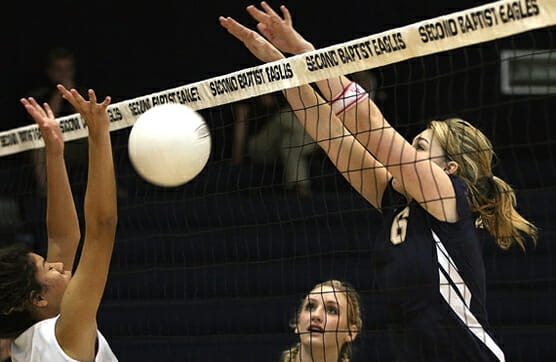Training the Female Volleyball Player: Q&A with Donnie Maib

Training the Female Volleyball Player: Q&A with Donnie Maib
Volleyball consists of dynamic, multi-directional movements in a confined space. The physical demands include reacting, accelerating, jumping, landing, pivoting, decelerating, and hitting. Therefore, the physical preparation of the volleyball player should consider aspects of vertical and horizontal training, rotational movements, and upper body strength to improve on-court performance and also decrease the risk of knee and shoulder injuries in the developing and veteran volleyball athlete.
In this blog, we are fortunate to interview University of Texas Volleyball strength and conditioning coach Donnie Maib, who shares his thoughts on program philosophy and methodology on training the female volleyball player.
Can you explain your overall philosophy of training and conditioning for volleyball?
My overall philosophy is a ground-based, multi-joint, multi-plane approach. In the weight room, I prefer using Olympic lifts, pulls, single leg variations, posterior chain emphasis, and auxiliary work (pull ups, posterior shoulder, dumbbell exercises, etc). I do have some athletes who cannot perform Olympic lifts. For these athletes, I choose the next best exercise that they can safely perform without any restrictions.
For conditioning, I use a lot of short-burst agility drills with an emphasis on stopping and starting. I will use some other fitness conditioning (tempo runs, hill work, stadium stairs) in the summer when they are not playing their sport. During the season, I use mostly low-impact cardiovascular work on machines (bikes, stairclimber, etc.).
What are some of your favorite exercises to develop lower body power for improving vertical jump?
My favorite exercise to develop vertical jump is the power snatch. This is a complex and highly technical lift so if I have an athlete who cannot perform it, I will use a dumbbell version or some sort of box jump variation as a replacement.
How much and how do you implement jump training (plyometrics)?
I use quite a bit of plyometrics to develop tendon and ligament strength. I have found that the smaller jumps are great for developing joint integrity. The bigger jumps are used mostly with strength exercises to contrast their training to get a better transfer.

What are your thoughts on loaded jump training such as the Perform-X Jump System? For jump training with the Perform-X cords, I feel it is essential. However, I do believe an athlete needs to be progressed into those types of exercises. I do not use them right away but take a few weeks of progressing to that type of resistance. When used properly, it is a great way to increase lower body power and explosiveness.
Do you ever incorporate resisted and assisted multi-directional movement into your training programs? If so, can you give some examples.
I do incorporate assisted multi-directional movements. I use this type of training in the spring and summer mostly – off-season training. I typically will use it with a weekly progression of band resisted short, quick cone drills. I don’t vary the exercises as much as I slowly progress the amount of resistance of the bands as well as the number of reps. This keeps it simple for me and I can see the improvement over time.


What is your approach to training the upper body and core/rotational power for the demands of volleyball?
For upper body training and core rotational power, I really like a lot of Med Ball work. I do use some anti-rotational work as shown in the photo here, especially during the in-season phase.
What are 3 things that every middle school and high school volleyball coach should understand about volleyball strength & conditioning?
- Train each athlete according to what season they are in. High School volleyball coaches often train girls hard in the off-season while they are in peak competition during the club season. This is just too much on their bodies. If this is the case, coaches should adjust the volume and intensities for those competing in club volleyball. Girls who are not playing club can train harder with more intensity and volume during the off-season.
- Put an emphasis on quality movement patterns (squat, hinge, pull, bracing, pressing) prior to heavy loading. Don’t focus on maxing girls out. The risk is high and the return is low.
- Focus on landing mechanics. Work more on landing properly versus maximum height during jumping exercises/plyos. Improvements in height will occur over time as they get stronger and play the game more. Bad landing mechanics can end a season fast if they can jump out the gym but land poorly.
About Donnie Maib
Coach Maib is in his 23rd year of coaching and is recognized as a Master Strength and Conditioning Coach, the highest honor for a coach in the strength and conditioning field. He currently oversees all aspects of athletic performance efforts for all sports at the University of Texas with the exception of Men’s/Women’s Basketball and Football, and directly works with women’s volleyball and men’s tennis. Coach Maib’s expertise goes beyond strength and conditioning as he is an influential leader and contributes greatly to building team culture.
Related Perform-X blogs
You can’t fire a cannon from a canoe: training the lower body
Fundamental Plyometric Training – Using Directional Plyometrics for Speed Improvement
Resistance Applications for Plyometrics
Converting Existing Lifting Platforms to Plyometric Stations
Two-Leg versus One-Leg Plyometric Applications: Is one better?